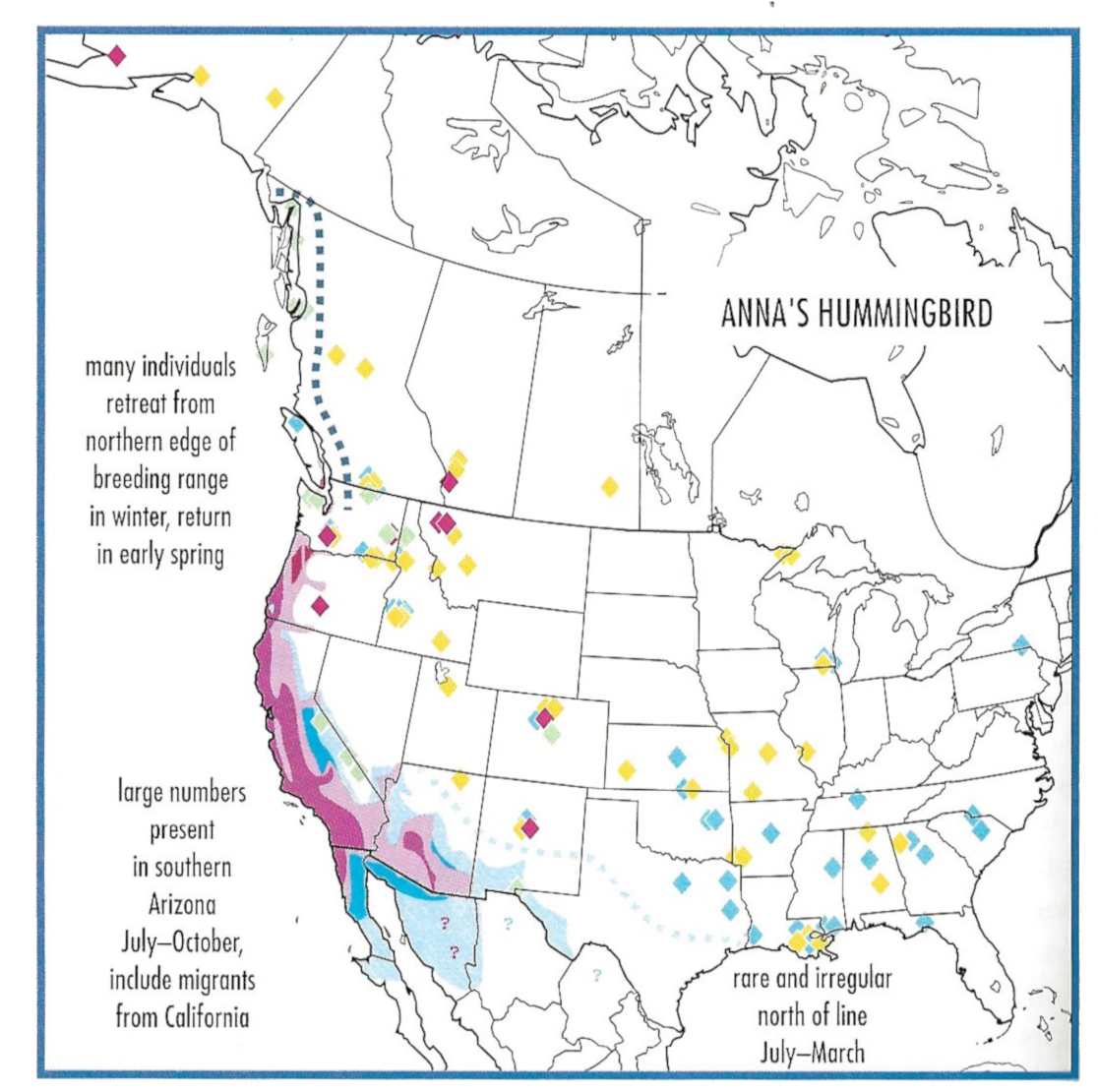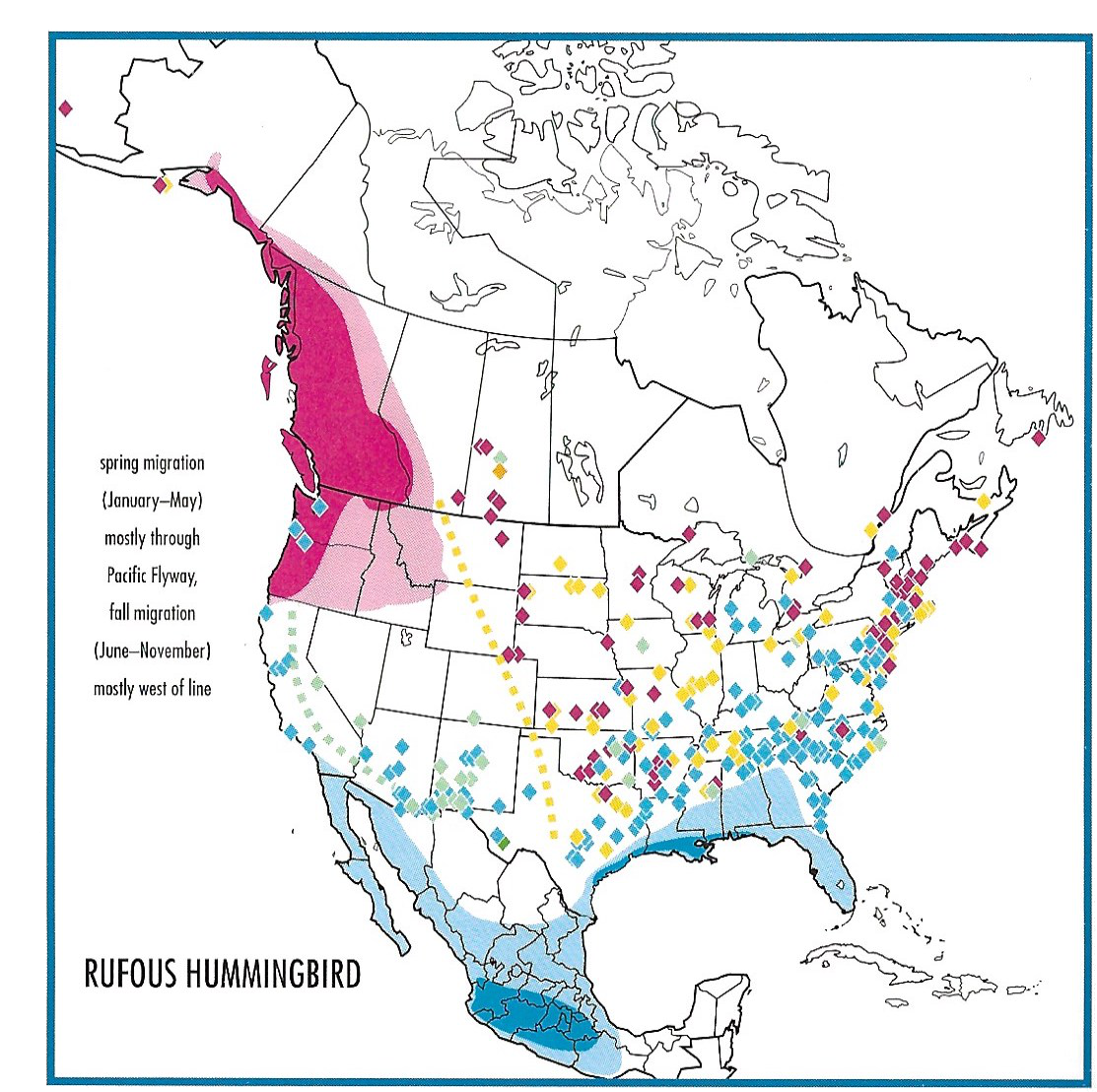Trying to identify the hummingbird zipping around your yard?
Hummingbirds are one of the most fascinating creatures that you can find in your backyard. It really helps to know what species of hummingbirds live in Wisconsin.
While the list below contains all the usual hummingbirds found in Wisconsin, it’s possible to find a vagrant species of hummingbird that’s not native to Wisconsin. This is rare but not unheard of.
The following legend can be used for each hummingbird species map to determine what time of year you can see each hummingbird in your area.


The 6 Hummingbird Species of Wisconsin

Anna’s Hummingbird
Calypte anna
Order: Apodiformes
Family: Trochilidae
Size: 3.5 – 4in (9-10cm)
Overview
Originally a native to California, the Anna’s Hummingbird is quite adaptable allowing it to expand its range northward and eastward chasing exotic flowers in urban gardens. It’s named in honor of Anna Massena, the Duchess of Rivoli and a generous patron of science. During the winter Anna’s hummingbird has been observed eating insects such as gnats and even eating sand and ashes – likely to provide essential minerals.
How to Identify
Anna’s Hummingbird is a medium-sized hummingbird with a medium sized straight black. bill. The male sports a red gorget. Unlike the Black-Chinned and Costa’s Hummingbird, Anna’s Hummingbird normally holds its tail still while hovering.
Anna’s Hummingbird Range & Migration Map
Anna’s Hummingbird is a common resident in California but has extended its range north towards the western coast of Washington and southeast to southern part of Arizona. It’s a rare winterer of western Texas.


Broad-Billed Hummingbird
Cynanthus latirostris
Order: Apodiformes
Family: Trochilidae
Size: 3.5 – 4in (9-10cm)
Overview
This southwestern hummingbird is one of the most mild-tempered. It’s rare to see two males fighting over territory or females. Their quite uninspired name comes from the literal translation of its species name – cynanthus latirostris. It’s sound is unique from all other North American hummingbirds as it consists mostly of raspy and almost insect-like chattering.
How to Identify
The male Broad-Billed hummingbird is easy to distinguish. Some of it’s more defining features include a long broad bill, long and constantly-moving tail, and a glittering sapphire blue neck.The female and male are close in size and proportions.
Broad-Billed Hummingbird Range & Migration Map
The Broad-Bill Hummingbird is a rare resident in shrub thickets and canyons. Most often found in southern Arizona and southwest New Mexico at elevations above 5,000ft. In migratory season, this hummingbird has also been sighted in Texas and California.


Green-Breasted Mango Hummingbird
Anthracothorax prevostii
Order: Apodiformes
Family: Trochilidae
Size: 4.2 – 4.7in (11 – 12cm)
Overview
This species of hummingbird is a vagrant traveling into the US from Mexico, and is usually a friendly visitor of wide-open spaces. They prefer traveling into backyards for easy feeding compared to deeper forests and wooded areas. These hummingbirds are particularly keen on snapping insects out of the air as they fly past.
How to Identify
A larger species than many, the Green-breasted mango is dark green to the plumage and has a bluish tint to the stomach. It’s also noted for having a large, curved bill. You’ll normally be able to tell a male by its red tail, while female tails are much darker. Females also have spots of white scattered across their bodies.
Green-Breasted Mango Hummingbird Range & Migration Map
Though rarer than native species, this hummingbird is a common vagrant to spot across Texas, though it’s been seen as far across as North Carolina, and has even been spotted out in Wisconsin and Georgia. Being a tropical bird, you are more likely to find it nesting down towards Central and South America.


Green-Violet Ear Hummingbird
Colibri thalassinus
Order: Apodiformes
Family: Trochilidae
Size: (9.7 – 12cm)
Overview
Otherwise known as the Mexican violet ear, this hummingbird is a vagrant species that frequent southern states via Mexico. It’s regarded as something of a nomad, and they tend to prefer forest clearings to breed in. They are some of the most striking hummingbird species traveling in this direction – though they are known to be quite aggressive, and will chase other species off a feeder.
How to Identify
This hummingbird has a stunning array of green plumes and purple patches to the ears, with a dark pair of wings and a blue-tinted tail. Telling the difference between males and females can be difficult, however, males are thought to be a little more striking or bold in color.
Green-Violet Ear Hummingbird Range & Migration Map
The green violet ear is a born wanderer, with more than 30 different records indicating visitations to eastern Texas in the past 60 years. However, it’s also been spotted traveling from Mexico and Central America as far and as wide as Alabama, Arkansas, California, Colorado, Kentucky, Louisiana, Michigan, Mississippi, Montana, North Carolina, Ohio, Oklahoma, and Wisconsin.


Ruby-Throated Hummingbird
Archilochus colubris
Order: Apodiformes
Family: Trochilidae
Size: 3.25 – 3.75 in (8.5 – 9.5cm)
Overview
The ruby-throated hummingbird is one of the most commonly found hummingbirds of the United States. In fact, it’s the only one that breeds east of the Mississippi River. To reach these eastern breeding grounds, the Ruby-Throated Hummingbird takes a perilous route of flying over 500 miles non-stop over the Gulf of Mexico.
How to Identify
This hummingbird is on the smaller side. The male sports a handsome scarlet gorget and a black chin strap which distinguishes it from the Anna’s and Broad-Tailed hummingbirds.
Ruby-Throated Hummingbird Range & Migration Map
The Ruby-Throated hummingbird breeds in eastern United States and prefers hardwood, pine and mixed forests starting in the spring and retreats to Mexico in the winter.


Rufous Hummingbird
Selasphorus rufus
Order: Apodiformes
Family: Trochilidae
Size: 3.5 – 4in (9 – 10cm)
Overview
The Rufous Hummingbird breeds farther north than any other hummingbird in the United States. It’s an aggressive species which makes it an unwelcome guest among hummingbird feeders. This hummingbird is an important part of the Pacific Northwest ecosystem, acting as a pollinator where the insects are at a disadvantage due to their cold-bloodedness.
How to Identify
The most distinguishing feature of the Rufous Hummingbird is the male’s rufous gorget that’s hard to miss. It’s a relatively small hummingbird with a short black bill. With the rufous plumage and aggressive behaviour, you’ll have no problem identifying male Rufous Hummingbirds.
Rufous Hummingbird Range & Migration Map
The Rufous Hummingbird breeds from the southeastern tip of Alaska down to the northern most parts of California, going as far east as Montana. During the winter, it migrates down to the Gulf of Mexico states.

How to Attract Wisconsin Hummingbirds to Your Yard
Want to see more hummingbirds in your backyard?
We have all the information you need on our site to help you do that. First, we recommend you read our guide on how to attract hummingbirds to your yard. That’ll give you the basics of what’s required to attract hummingbirds.
Then, we’d recommend reading our buyer’s guide on choosing the best hummingbird feeder. Setting up a hummingbird feeder or two is the best way to guarantee that hummingbirds will visit your yard.
There are a bunch of other ways to attract hummingbirds such as getting a bird bath and planting native flowers that attract hummingbirds.
All State Hummingbirds
Want to see what hummingbirds species are found in other states? Here’s our complete list of hummingbirds found in each state:
